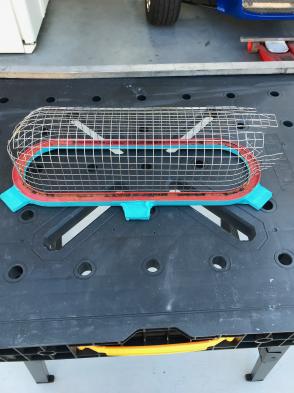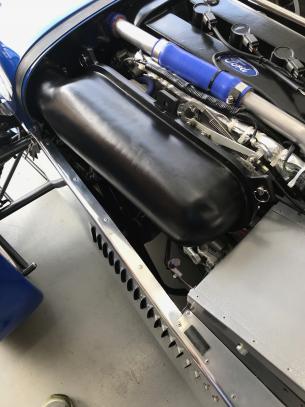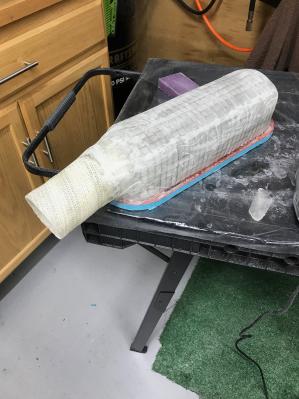-
Posts
476 -
Joined
Content Type
Profiles
Forums
Store
Articles
Gallery
Events
Library
Everything posted by papak
-
I’m still waiting for a reasonably priced electric pickup truck.
-
On the advice of another owner, I welded a threaded bung in the right front corner of the cover to facilitate future servicing of the gearbox. Once you have filled the gearbox, you can mark a dipstick for reference. The right front corner is a location where the dipstick will reach the bottom of the case without screwing anything up. I have suctioned out the gear lube in the past through this port. I eventually got got tired of the oily residue that accumulates on the top of the cover. The box is vented through a small hole in the cover that is baffled by an internal plate attached to the upper selector shaft pivot. I recently welded an AN-4 bung in this location (after drilling it to size). I attached a 12” SS hose using a 90 degree fitting and a straight fitting at the other end. To this I attached a cross drilled cap and secured it to the frame in front of the tunnel opening. Now everything stays clean and dry.
-

Leaky Gearbox - Superformance S1 (Zetec w/ Ford Type 9)
papak replied to Driven's topic in General Tech
I found that the selector shaft was the source of the leak on my T9. Meticulously clean the surfaces and carefully apply either Hylomar or rev. Bone dry ever since. -
Depending on the motor mounts, you could experience a fair amount of vibration in the gauge mounted directly on the rail. It will also pose a clearance issue with the bonnet. I use an inline mount (Earls, Summit) on the supply line as it exits the tunnel and comes up to the rail. Most of the gauges are fluid damped as well.
-
I use a Facet to fill the swirl pot and a Waldron 392 for high pressure. I route the excess from the fuel regulator to the swirl pot as well with a return from the top of the swirl pot to the fuel tank.
-
The Duratec fuel rail has a return fitting on the end. I capped mine and run it as a “dead head” as you describe with no problem. Find a fuel rail that doesn’t have the pulse dampener. It’s a pain to plug and looks ugly in the finished car. I went the swirl pot route but may modify my tank opening to accept an integral pump in the future. The Duratecs require 42-43 psi at the rail. Either use new injectors or have the old ones cleaned and recalibrated. It really makes a difference.
-
The oily film in the top of my T-9 transmission has bugged me since I built the car. While I recently had the drivetrain out of the car, I decided to fix it once and for all. The car is vented through a small hole in the bump on the top cover. This hole is intentionally placed over the the reinforcing bracket that serves as the fulcrum for the upper selector rod. This is due to the swirl pattern of the lubricant when underway. This location allows the pressure to vent but a bit of oily vapor also escapes over time (probably why they built the cover with a lip all around it). I welded on a steel AN-4 bung after drilling the correct diameter in the top over using the original vent hole as a pilot. I fabricated a 12" ss braided hose using a 90 degree fitting on the transmission end and a straight fitting on the other. This I simply bent 90 degrees and secured with a bracket near the rear of the engine (the minimum bend radius for -4 hose is 2"). I covered the end with an end cap that I had cross-drilled. After a couple of 30 minute runs in 80 degree weather yesterday, no residue was observed. Should I start to see evidence of lube at the vent, I can always extend it to a catch can.
-
The viscous LSD was definitely the culprit. After some networking, I purchased a freshly rebuilt R160 with an AP Suretrac LSD from ZF Design (thezfdesign@gmail.com) outside of Denver, CO. They rebuild Subaru drivetrain components for the offload crown over there. Zach Fothergill was quite knowledgable about the compromises between the various LSDs. He can also provide any of the final drive ratios offered by Subaru. At any rate, while the drivetrain was out of the car, I took the opportunity to replace the front cover of the engine (slight crack) and re-index the cams. Crower originally ground them with 4 degrees of advance for emissions compliance. I added adjustable cam sprockets but the indexing was slightly off as this was originally done with the engine installed in the car (either way, it is definitely a two person project). With the cams now indexed to a zero datum, I should theoretically have a bit more torque. As the car hasn't been dynoed, I really don't know. It does seem very slightly smoother under acceleration. Gratifyingly, no leaks after the first weekend of running after everything was back in the car. Great to be back on the road again!
-
I have some Duratec accessories if you end up needing them. New starter, cam covers, stock cams, ITG air filter for the ITBs... Good luck
-
I started racing at the original PBIR in the mid ‘70s. I went through a a couple of Formula Vees there. It was a very competitive group, producing several National Champions (Don Whitney?, George Fissel). There was a drainage canal at the end of the back straight that sucked in a car or two a season. They ended up requiring a diver to be suited up and ready to goin for every SCCA event. I recall a PCA track day there where Gerry Sutterfield looped his 917K on the back straight! Great times! Glad that the track has been updated.
-
John Esposito at Quantum is the only guy I know. He is a bit hard to get hold of. Try him first thing in the morning East Coast Time. I heard that there may be some in Canada but I don't know anyone specific.
-
For those of us that use a Subaru differential, I finally found a reliable and knowledgeable source in the Denver, ZF Industries (303-548-2624). This started out because I fried a viscous LSD in my R160 diff. Zach is shipping me a freshly rebuilt R160 with a Suretrac LSD. All this considered, $900 off the shelf seemed reasonable. He can also set it up with any of the available R&P options as well.
-
I recently found myself in need of an input shaft bearing for my T9 transmission. The search took about 6 hours over two days. Because of timing, I ended up ordering it from Burton in the UK with express shipping but I did end up finding some in the US. Apparently, an outfit in Oregon, Rapido Group (541-544-3322) seems to have acquired much of the NOS stock of Mercury Mercur parts in the US including many T9 parts. BAT Industries also has some parts but they didn't have the bearing I needed. Pretty brusque on the phone as well. The fellows at Burton were great as usual plus the exchange rate is pretty good right now thanks to Boris. Shipped express on Thursday, I should have it Saturday!
-
My Birkin came with 175/F, 200/R for what it is worth (QA-1 shocks set full soft). From what I have heard, this is a fairly standard starting point. The cars are so light that they don't respond well to much heavier spring rates.
-
Try the factory five forum. There is also a woman who works in the Thousand Oaks DMV office who is purportedly very sharp on the SPCNS process. I heard this through a Cobra kit car forum. There are only a few of us active on the California Caterham Forum. Good luck!
-
According to the Subue forums, the viscous unit is sealed and non-repairable. It is filled with a silicon based lube with unique shear qualities. The diff itself uses GL-5. In my case, it seems as though the silicon stuff has been fried.
-
My Birkin uses a Subaru R160 viscous LSD. While at the track a couple of weeks ago, I lost about 90% of the forward drive in a 3rd gear sweeper. It was initially felt like a burned clutch (but on recollection, there was no “burned clutch” smell). After removing the engine, the clutch, slave cylinder and spacing criteria all seem spot on. After eliminating the clutch, the only remaining culprit seems to be the diff. When I initially built the car, I thought that a viscous LSD would be sufficient for the motor (2.3l Duratec with ITBs, 9.7:1 and Stage 1 cams, maybe 180-190 hp). I’m still trying to figure out a productive way to check the LSD. When the driveshaft is turned, both rear wheels rotate in the same direction as they should. The question is if the do so under load. I was able to drive the car into the garage from the trailer but it didn’t feel like it was fully connected. Not sure quite how to describe it any better than that. Any ideas?
-
Unless you are using huge injectors, the Duratecs run at 42-43 psi.
-
Get a thread gauge and measure what you have. Try [boltdepot.com] as they offer a wider range of metric sizes and quality. I've used them in the past for unique fitments.
-
I have an XS Birkin in LA that you are welcome to try. It is cavernous compared to an S3 but the pedal box is the most rewarding difference. PM if you are interested.
-
I instructed for PCA in the Northeast years back and for POC when we moved to California. It was a fatality during a DE at Lime Rock that brought in the mandatory seat back brace. We really tried to control the events by being very conservative when releasing drivers to "solo". We also restricted the passing zones and often held mandatory mid-day drivers meetings to review the mishaps of the morning sessions. With both organizations, one of the biggest points of discussion was the level of automation in the new cars. If those electrons ever stop holding hands in a 996 going into Turn 8 at WSIR, you better hope the roll bar is sturdy. We also tried to build the run groups by performance capability as well as driver ability. we were pretty strict on safety equipment as well. Once running with POC on the West Coast, I was one of the first in our group get a HANS device. I took a bit of ribbing for wearing it for DE events but it soon took hold. I happened to be in Atlanta on a layover and went to Jim Downing's shop to scope them out. He was starting to make them to order for a number of pro drivers. After a brief conversation, I placed my order. I understand the new ones are much more refined and lighter. The thing with instructing is that if the more experienced members don't pitch in, you are left with no instruction at all. It helps feed the pipeline of drivers who may eventually move up to club racing and that, to my way of thinking, is worthwhile. I would rather have a hand in the process than trust to fate entirely. Just my $.02
-

2.3 or 2.5 Duratec/MZR in Birkin S3
papak replied to JeffersonRaley's topic in General Sevens Discussion
The Raceline dry sump and wet sump both have nearly the same depth below the block. No help there. They both fit inside the Birkin skid plate. After driving mine for 2000 mi., I would be reluctant to NOT use the skid plate. I'm pretty careful and I still have some dents in mine. The 2.5 is the same height as the 2.3 (the bore is larger on the 2.5). The front of the T-9 ends up being the low point. You could probably grind off ¼" or so. Tom Carlin ((970) 376-5188) can probably supply the correct engine mounts. He also offers a lower cam cover that keeps everything below the aft edge of the nose. -
As you can see, I haven't fully mastered attachments.
-
I have been interested in improving the performance of my 2.3l Duratec with an eye toward cost effectiveness. Toward this end, I decided to fabricate a cold air induction system. It seems that the consensus is that you gain 1% for each 10 degree drop in inlet temperature. From a closer look at the physics, this relationship varies with the temperature range but for our purposes, that ratio is reasonably accurate. I found a very nice airbox on the Jenvey website for $275 and another nice one on the SBD site for $592. The several others I found are in that price range. Ouch! I had an old ITG “sausage” type filter sitting in the shop with worn out foam on it. This would normally cover the four 48mm ITBs with 50mm tall trumpets. I stripped off the foam and found that the underlying stainless steel screening is epoxied to the base. I opened up the front end of the screening to accommodate a 3” fiberglass tube. I then used an ultra fine fiberglass tape normally used for drywall seams to cover the outside of the shell. This stuff works great as it has a light adhesive on one side and is easily trimmed with scissors. I used some expoxy saturated mat on the inner surface. Once all of this set up, I hit it with some 80 grit. This was followed by a fair amount of lightweight filler in several thin layers interspersed by sanding. Using a couple of manilla file folders, I determined the outline of the necessary blocking plate to fit the drover’s side of the nose fairing opening next to the radiator. This was transferred to aluminum sheet, cut and bent as necessary and mounted to the radiator mounting bracket. This was then trimmed to accommodate a 3” aluminum tube. The tube was mounted so that it extended in front of the radiator. I mounted a foam “sock” type air filter (Uni NU-2483ST) in the front of the tube (treated with K&N filter oil). This filter (or similar) can be found in many motorcycle or ATV shops. Aside from the potential power gain, the impact on engine sound is noticeable. This cancels nearly all of the intake noise and consequently, makes the exhaust sound crisper. I considered fabricating a rubber baffle to surround the entire radiator (as in light aircraft installations) but the present cooling system works great as-is and the under-hood temps are not uncomfortable. There are 152 louver cut into the bonnet of the Birkin. This, in combination with the airflow around the radiator, eliminates the transmission tunnel heat issue entirely. http://www.usa7s.net/vb/attachment.php?attachmentid=15275&stc=1http://www.usa7s.net/vb/attachment.php?attachmentid=15273&stc=1http://www.usa7s.net/vb/attachment.php?attachmentid=15274&stc=1 In the end, the total cost was under $100.




